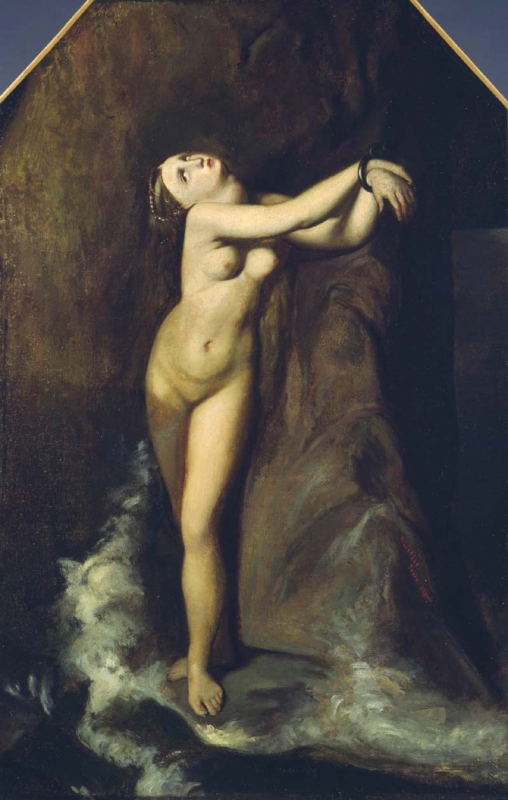Composition
Whistler probably painted his copy of Ingres' Roger délivrant Angélique from the version exhibited at the Salon of 1819, which was, by 1857, in the Musée du Luxembourg, Paris. 1 Ingres was director of the École des Beaux-Arts and, until his death in 1867, the leading Classicist painter in Paris.
Ingres' Roger délivrant Angélique of 1819 measures 147 x 190 cm. Whistler's partial copy is much smaller, at 82 x 53 cm. Whistler's copy shows approximately one third of the composition, omitting details such as Roger's lance, which in the original cuts across the lower part of Angélique's legs, and the sea monster. Pentimenti show that Whistler originally painted Angélique's left leg further to the left.
Technique
The canvas is a medium weight plain tabby weave. The priming appears to be white, and the paint, at least at the edges, thin. 2 An underdrawing in graphite pencil is just visible for her left foot and toes.
According to Thomas Armstrong (1832-1911), Whistler's painting 'was not a bit like that of Ingres, for it was done in a thin, transparent manner, with no impasto and hardly enough paint to cover the canvas, also the colour of it was warmer and richer than that of the original'. 3 Armstrong went on to say that when he reproached Whistler for stinting on paint, 'he replied that the price he was to be paid would not run to much more than good linseed oil for he was to have only 100 francs apiece for the copies'. 4
Areas of the copy are thinly but carefully painted, but on the body, there is thick paint (for instance over her breasts, arms and face), painted with no thinner or medium modifier, the modelling consisting largely of softly blended shadows, not brushstrokes. Professor J. H. Townsend comments that, for most of his life, Whistler would work in the opposite way. 5
In its present condition it is hard to assess the original technique.
Conservation History
It was lined shortly before acquisition by the Hunterian in 1969, using very pale and fine weave canvas, the edges being taped with brown tape
The paint is thin and the surface has been abraded by overcleaning, although records of earlier restoration are lacking. There has been considerable retouching, particularly on the background and damaged areas including a 30 cm tear at lower left, beside the woman's leg. However, the condition and appearance of the painting is quite good. 6
Frame
Modern frame, 97.5 x 69.0 x 6.0 cm.
Last updated: 25th November 2020 by Margaret







